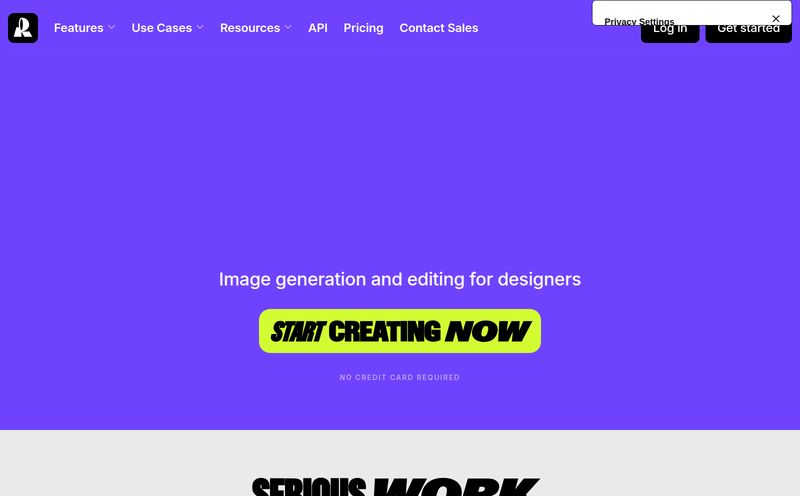There's a weird, universal human curiosity, isn't there? The one that whispers, "I wonder what I'll look like when I'm older." We've all done it. Squinted in the mirror, pulled at our skin, tried to imagine the roadmap of wrinkles and silver hair. For years, the tools to satisfy this curiosity were, let's be honest, garbage. Clunky apps that slapped a generic 'old person' filter on your face, making you look less like your future self and more like a melted wax figure.
So, when I stumbled upon a new browser-based AI Face Ager, my inner SEO-nerd and my general curiosity collided. I’m a sucker for testing new AI tools, especially when they promise something as personal as a glimpse into the future. And this one promised it for free. No downloads, no sign-ups, just a straight-up digital time machine. Skeptical? Absolutely. But I couldn't resist. And what I found was... well, it was a lot more than I expected.
First Off, What Is This Digital Fountain of... Age?
In a nutshell, this AI Face Ager is a clever online platform that uses artificial intelligence to realistically simulate the aging process on your face. You upload a photo, and the AI gets to work, analyzing your unique facial structure—your eyes, your nose, the shape of your jaw—and then applies a natural-looking aging effect. It’s not just adding a few lines; the goal is to show you a believable progression. The tech aims to retain the essence of you, just... with more life experience etched onto your face. It's like having a sneak peek at the 'you' from 20, 30, or even 40 years down the line.
My Trip Through the Time Machine: The Experience
The process itself is ridiculously simple. You head to the site, hit the 'upload' button, and pick a photo. Now, here's my first pro-tip, and it's an important one: the quality of your input photo matters. A lot. My first attempt was a candid shot from a friend's barbecue—bad lighting, weird angle. The result was... abstract art. Let's just say my future self looked like he’d had a rough go of it.
For my second attempt, I took a fresh selfie. Straight on, decent lighting, neutral expression. The classic passport photo vibe, you know? I uploaded it and waited. And I mean, I waited... for all of five seconds. It was fast. Shockingly fast. The kind of fast that makes you question the complexity of the task.

Visit AI Face Ager
And then, there he was. Future Me. I stared at the screen for a solid minute. It was uncanny. The AI had added crow's feet that seemed to branch out from my actual smile lines. My jawline was softer, and there was a sprinkle of grey in my digital beard that felt... right. It wasn't some generic grandpa filter. It was recognizably me. I showed it to my wife, and she just went, "Wow. Yeah, I can see that." High praise, let me tell you.
The Good, The Bad, and The Wrinkly
Like any tool, it's not perfect. But it gets a lot of things right. Let's break it down.
What Genuinely Impressed Me
The biggest win here is the realism. For a free tool, the high-definition output is fantastic. The aging effects are subtle and build upon your existing features, which is the secret sauce. Instead of just plastering a texture over your face, it seems to understand where skin would naturally sag or wrinkle. I've seen some paid apps that don't do this as well. The speed and ease of use are also major pluses. There's no learning curve. It's a single-serving tool that does its one job incredibly well. It’s a far cry from the over-complicated software we sometimes see in the creative space. This is plug-and-play fun.
A Few Things to Keep in Mind
Now for the reality check. As I mentioned, it's a bit of a diva about the photo you feed it. It really needs a clear, front-facing portrait. Any shadows or odd angles can throw the AI off, leading to some wonky results. So, take a moment to get a good source image; it's worth the extra 30 seconds. Also, let's be real, this is an AI's best guess. It's not a prophecy written in stone. It's a fun, speculative tool. Don't go planning your future skincare routine based solely on what it shows you, okay?
More Than Just a Party Trick? Some Creative Uses
While my initial use was pure vanity and curiosity, my mind quickly started racing through other potential applications. Think about it:
- For Writers and Creators: Are you a novelist or a D&D Dungeon Master? You could generate portraits of your characters at different stages of their lives to help you visualize their story arc.
- A Fun Family Project: Imagine taking old photos of your grandparents and running them through a 'de-aging' filter, or showing your kids what they might look like when they're your age. It's a new kind of family album.
- Social Media Gold: Obviously. The 'FaceApp challenge' blew up a few years ago for a reason. This is a quick and easy way to create some seriously engaging content for your feed without downloading yet another app. Some might even say it's a great way to generate traffic to your own blog... just saying.
I even found a fascinating article from MIT's CSAIL about the complexities of AI photo retouching, which just goes to show how sophisticated this technology is becoming. It's not just a filter; it's complex algorithmic work.
So, What's the Price for This Glimpse of Tomorrow?
Here’s the best part. Right now, it's free. As in, zero dollars, no credit card required, totally gratis. This is a huge selling point. Of course, in the world of online tools, 'free' can be a temporary state. I wouldn't be surprised if they introduce premium features or a subscription model down the line if the tool gains popularity. But for now, you can jump in and play around without opening your wallet, which is a rare treat.
Frequently Asked Questions About AI Aging
Is the AI Face Ager tool safe to use?
From what I can see, it's a browser-based tool, so you're not installing anything on your device. Most sites like this process the image and don't store it long-term, but it's always smart to be cautious with personal photos. I'd advise against using a photo you wouldn't be comfortable having online. Use your best judgment, as you would with any online service.
How accurate is the age progression really?
It's impressively realistic but think of it as an 'artistic rendering' rather than a scientific certainty. The AI makes educated guesses based on tons of data, but it can't account for lifestyle factors like diet, sun exposure, or stress. It's one possible future, not the future.
Can I use it on photos of my friends or celebrities?
Technically, yes, you can upload any photo that meets the criteria. But, you know, be cool about it. Using your own face is one thing, but maybe get your friend's permission before you age them 40 years and post it on Instagram. It’s just good karma.
Do I need to download any software?
Nope! That's one of its best features. It runs entirely in your web browser, which makes it super accessible and quick to use on a computer or phone.
What kind of photo gives the best results?
A clear, well-lit, front-facing portrait with a neutral expression. Think of a driver's license photo, but maybe with a slightly less pained look on your face. Avoid hats, sunglasses, and heavy shadows.
Is it actually free?
As of my testing, yes, it's 100% free to use. No hidden fees or trial periods. That could always change, but for now, it's a free-for-all.
Final Thoughts: Is It Worth Your Time?
Look, the AI Face Ager isn't going to solve world hunger or do your taxes. But that's not the point. It’s a fantastic, slightly unnerving, and genuinely fun piece of technology. It's a digital mirror that offers a momentary connection to a version of yourself that doesn't exist yet. It sparked conversations, made me laugh, and honestly, made me feel a little more comfortable with the whole idea of aging.
It’s a reminder that getting older isn't about fading away; it's about becoming a more detailed version of yourself. And if an AI can see that, then maybe we can too. Give it a shot. The worst that can happen is you'll meet your future self a little ahead of schedule.
References and Sources
- MIT News: An AI model that can retouch photos, artist-style - An article from the MIT Computer Science and Artificial Intelligence Laboratory (CSAIL) discussing related AI image manipulation technology.



